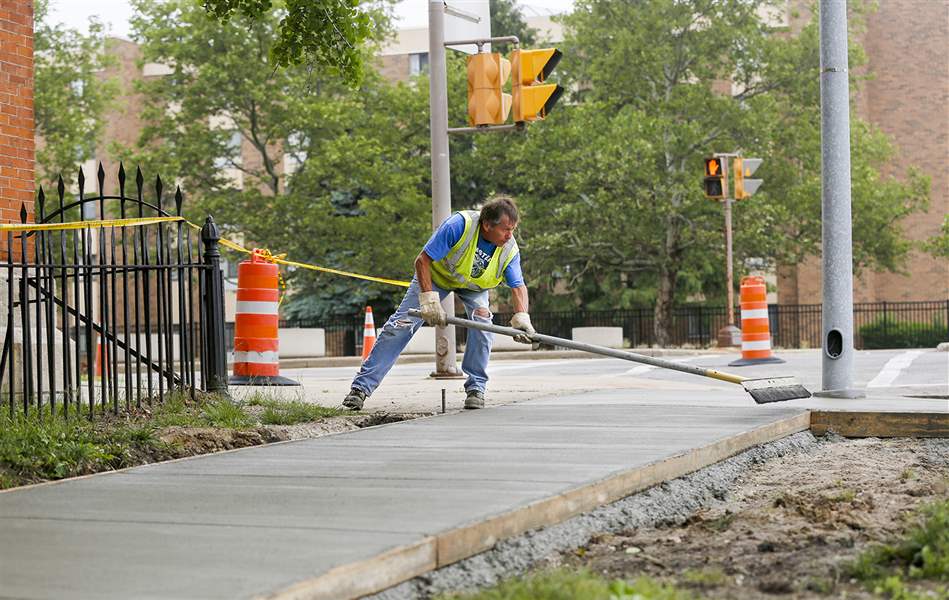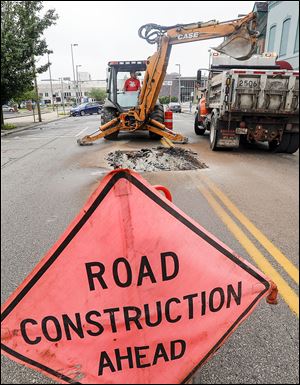
STREETS NOT CITY’S ONLY PROBLEM
Routine maintenance is ignored, creates backlog
Sidewalks, sewers, water lines await needed repairs throughout Toledo
6/15/2015
Eddie Garcia, a worker with Toledo’s Division of Streets, Bridges, and Harbor, levels the concrete sidewalk and curb installed as part of repairs along North Superior Street near Cherry Street.
THE BLADE/AMY E. VOIGT
Buy This Image

Eddie Garcia, a worker with Toledo’s Division of Streets, Bridges, and Harbor, levels the concrete sidewalk and curb installed as part of repairs along North Superior Street near Cherry Street.
Second of three parts
For a period of weeks, a solitary orange construction barrel occupied part of the left lane of westbound Main Street just before the traffic light at Riverside Drive and Boers-Boyer Way.
Beneath that barrel was a small but seemingly bottomless hole — a portal to what city officials say was a partially failed sewer pipe under the East Toledo street.
“We’re going to try to do a pipe patch on it,” Calvin Harris, manager of sewers for the city division of sewers and drainage, said shortly before the barrel disappeared and the hole was patched. “It’s on a list to be repaired. If it was a major priority, it’s something we would have done weeks ago.”
Along with its 1,224 miles of streets, Toledo has a commensurate network of sidewalks, water and sewer mains, and, in some areas, storm drains.
For the most part, none of it has routinely scheduled maintenance.

Instead, officials from several branches of city government said, repairs are made mainly in response to evidence of trouble: water backing up into basements or bubbling out of the ground, depressions or holes in street pavement, and the like.
PART ONE: Toledo’s bumpy streets amount to a $1.3B mess
Toledo keeps track of these issues with Cityworks, a database and tracking software program into which a growing number of city departments enter tasks that need attention.
“It helps us focus where to put our resources and devote attention to volume areas,” said David Welch, commissioner of the Division of Streets, Bridges, and Harbor.
As of late last month, the streets division had a list of more than 800 repairs awaiting action, Mr. Welch said.
That included sidewalks that need restoration and pavement that requires permanent repairs after receiving temporary patches to close up holes dug for whatever reason.
“The utilities patch their own repairs,” the streets commissioner said. “We don’t touch them until the asphalt companies open up in April. Then we start working them down.”
Mr. Harris said the sewer division, too, is “a couple hundred jobs behind,” with division crews completing two repairs per day, on average.
While Toledo’s sewer rates have soared in recent years, the additional millions of dollars have gone toward the Toledo Waterways Initiative — the court-settled mandate to substantially reduce the city’s use of treatment-plant bypasses to handle sewage overflows during heavy rain.
Those bypasses historically dumped huge volumes of untreated sewage into the Maumee River and other rivers, and they are being replaced by a combination of gigantic underground holding tanks, and, in some neighborhoods, construction of new sewer mains while the old ones are converted to use as storm drains.
“There’s nothing going into routine replacement,” Mr. Welch said. “There’s no funding to put a plan together.”
Mr. Welch said it can take up to a year for his division to permanently repair a street or sidewalk once whatever caused it to be dug up is fixed.
Crews start each season with a long list of repairs left behind by winter utility work plus anything not done the previous year.
New needs that arise during the warmer months may not get attention right away.
The streets division’s street-repair budget this year is $5.6 million, which covers pothole patching, crack sealing, and minor pavement repairs such as those along the Anthony Wayne Trail. It does not include snow and ice control, which is paid by special assessments.
Mr. Welch said he hasn’t calculated how much the streets division’s repair backlog would cost to catch up if funds suddenly became available, because to handle a heavier workload he’d need more workers.
But there is clearly several million dollars, at least, of minor repairs that could be done sooner if the money were there, he said.
The city does some preventive work on its underground utilities.
About 50 miles of major sewer lines are inspected annually using remote television cameras, and analysis from those inspections has led to projects such as the recent sewer reconstruction on Jefferson Avenue near Michigan Street, said Doug Stephens, commissioner of engineering services.
The city also reviews the condition of underground utilities when a major street reconstruction is planned.
When Secor Road was rebuilt between Central Avenue and Monroe Street two years ago, for example, an aging city water main beneath it was replaced first.
Columbia Gas, in the midst of a major pipeline-renewal campaign in Toledo, also replaced its mains near Secor then.
This reduces the risk that a freshly rebuilt street will get torn up a short time later for utility work, officials said, although that risk is never entirely eliminated.
While an inspection can give a sewer or water main a clean bill of health, Mr. Stephens said as an example, a problem could arise with a building’s service line right after a street project’s completion.
And not all of the rough spots and mystery holes along Toledo’s street network are caused by problems with the city’s utility network.
At Front and Main streets in East Toledo, an orange barrel had marked a collapsing manhole that provided access not to the water or sewer systems, but rather to an underground Toledo Edison vault.
“We notify them, and there’s not really much we can do after that,” Mr. Harris said.
“I hit a sinking catch basin on Monroe Street,” Mr. Welch added. “It turned out to be a gas-company problem.”
A widening hole in the grass next to Oakdale Avenue near Tracy Street in East Toledo is evidence of another problem that occasionally develops, Mr. Harris said: the failure of a privately owned underground pipe.
“It’s a private main, so we cannot dig,” he said. “We run into them every now and again. We’ve even backfilled it [that hole] a few times.”
Perhaps lowest on the city’s repair list are the decorative brick crosswalks installed at several dozen intersections, most of them in and near the central business district downtown, during the 1990s.

As of late last month, the city’s streets division had more than 800 repairs awaiting action, such as work shown here in front of 426 N Superior St. last week.
While a few are fairly intact, many have been marred by utility excavations that were patched afterward with regular asphalt.
Still others, such as those at Cherry and Summit streets and along the downtown bus loop, have been pounded for years by truck and bus traffic, causing the sand layer to shift and make the bricks uneven.
In a few cases, those pseudo-potholes have been leveled off with blacktop. And that, Mr. Welch said, is the most the city is likely to do with any of them.
“Right now there are other priorities we need to get to,” the streets commissioner said. “I don’t see us getting to it. When you start the season with over 900 restorations, if it’s already rideable, already driveable, you leave it alone.”
Further complicating crosswalk repairs at sites where utility work was done, Mr. Stephens said, is that the bricks are probably gone.
“If it’s a private utility, they were dug up with the dirt and hauled away,” he surmised.
Contact David Patch at: dpatch@theblade.com or 419-724-6094.